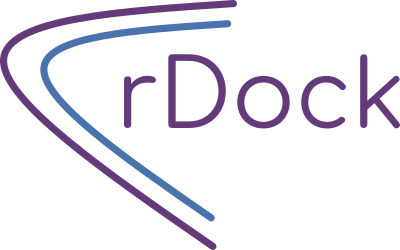Molecular files and atom typing¶
Macromolecular targets (protein or RNA) are input from Tripos MOL2 files
(RbtMOL2FileSource class) or from pairs of Charmm PSF (RbtPsfFileSource
class) and CRD (RbtCrdFileSource class) files. Ligands are input from MDL
Information Systems (MDL) structure data (SD) files (RbtMdlFileSource
class). Explicit structural waters are input optionally from PDB files
(RbtPdbFileSource class). Ligand docking poses are output to MDL SD files.
The rDock scoring functions have been defined and validated for implicit non-polar hydrogen (extended carbon) models only. If you provide all-atom models, be aware that the non-polar hydrogens will be removed automatically. Polar hydrogens must be defined explicitly in the molecular files, and are not added by rDock. Positive ionisable and negative ionisable groups can be automatically protonated and deprotonated respectively to create common charged groups such as guanidinium and carboxylic acid groups.
MOL2 is now the preferred file format for rDock as it eliminates many of the atom typing issues inherent in preparing and loading PSF files. The use of PSF/CRD files is strongly discouraged. The recommendation is to prepare an all-atom MOL2 file with correct Tripos atom types assigned, and allow rDock to remove non-polar hydrogens on-the-fly.
Atomic properties¶
rDock requires the following properties to be defined per atom. Depending on the file format, these properties may be loaded directly from the molecular input file, or derived internally once the model is loaded:
Cartesian (x,y,z) coordinates
Element (atomic number)
Formal hybridisation state (sp, sp2, sp3, aromatic, trigonal planar)
Formal charge
Distributed formal charge (known informally as group charge)
Tripos force field type (rDock uses a modified version of the Sybyl 5.2 types, extended to include carbon types with implicit non-polar hydrogens)
Atom name
Substructure (residue) name
Atomic radius (assigned per element from
$RBT_ROOT/data/RbtElements.dat)
Note
The rDock scoring functions do not use partial charges and therefore partial charges do not have to be defined. The atomic radii are simplified radii defined per element, and are used for cavity mapping and in the polar scoring function term, but are not used in the vdW scoring function term. The latter has its own indepedent parameterisation based on the Tripos force field types.
Difference between formal charge and distributed formal charge¶
The formal charge on an atom is always an integer. For example, a charged carboxylic acid group (COO-) can be defined formally as a formal double bond to a neutral oxygen sp2, and a formal single bond to a formally charged oxygen sp3. In reality of course, both oxygens are equivalent. rDock distributes the integer formal charge across all equivalent atoms in the charged group that are topologically equivalent. In negatively charged acid groups, the formal charge is distributed equally between the acid oxygens. In positively charged amines, the formal charge is distributed equally between the hydrogens. In charged guanidinium, amidinium, and imidazole groups, the central carbon also receives an equal portion of the formal charge (in addition to the hydrogens). The distributed formal charge is also known as the group charge. The polar scoring functions in rDock use the distributed formal charge to scale the polar interaction strength of the polar interactions.
Parsing a MOL2 file¶
MOLECULE, ATOM, BOND, and SUBSTRUCTURE records are parsed. The
atom name, substructure name, Cartesian coordinates and Tripos atom type are
read directly for each atom. The element type (atomic number) and formal
hybridisation state are derived from the Tripos type using an internal lookup
table. Formal charges are not read from the MOL2 file and do not have to be
assigned correctly in the file. Distributed formal charges are assigned directly
by rDock based on standard substructure and atom names as described below.
Parsing an SD file¶
Cartesian coordinates, element and formal charge are read directly for each
atom. Formal bond orders are read for each bond. Atom names are derived from
element name and atom ID (e.g. C1, N2, C3). The substructure name is MOL.
Formal hybridisation states are derived internally for each atom based on
connectivity patterns and formal bond orders. The Tripos types are asssigned
using internal rules based on atomic number, formal hybridisation state and
formal charges. The integer formal charges are distributed automatically
across all topologically equivalent atoms in the charged group.
Assigning distributed formal charges to the receptor¶
rDock provides a file format independent method for assigning distributed formal charges directly to the receptor atoms, which is used by the MOL2 and PSF/CRD file readers. The method uses a lookup table based on standard substructure and atom names, and does not require the integer formal charges to be assigned to operate correctly.
The lookup table file is $RBT_ROOT/data/sf/RbtIonicAtoms.prm. Each section
name represents a substructure name that contains formally charged atoms. The
entries within the section represent the atom names and distributed formal
charges for that substructure name. The file provided with rDock contains
entries for all standard amino acids and nucleic acids, common metals, and
specific entries required for processing the GOLD CCDC/Astex validation sets.
Important
You may have to extend RbtIonicAtoms.prm if you are working with
non-standard receptor substructure names and/or atom names, in order for the
distributed formal charges to be assigned correctly.
